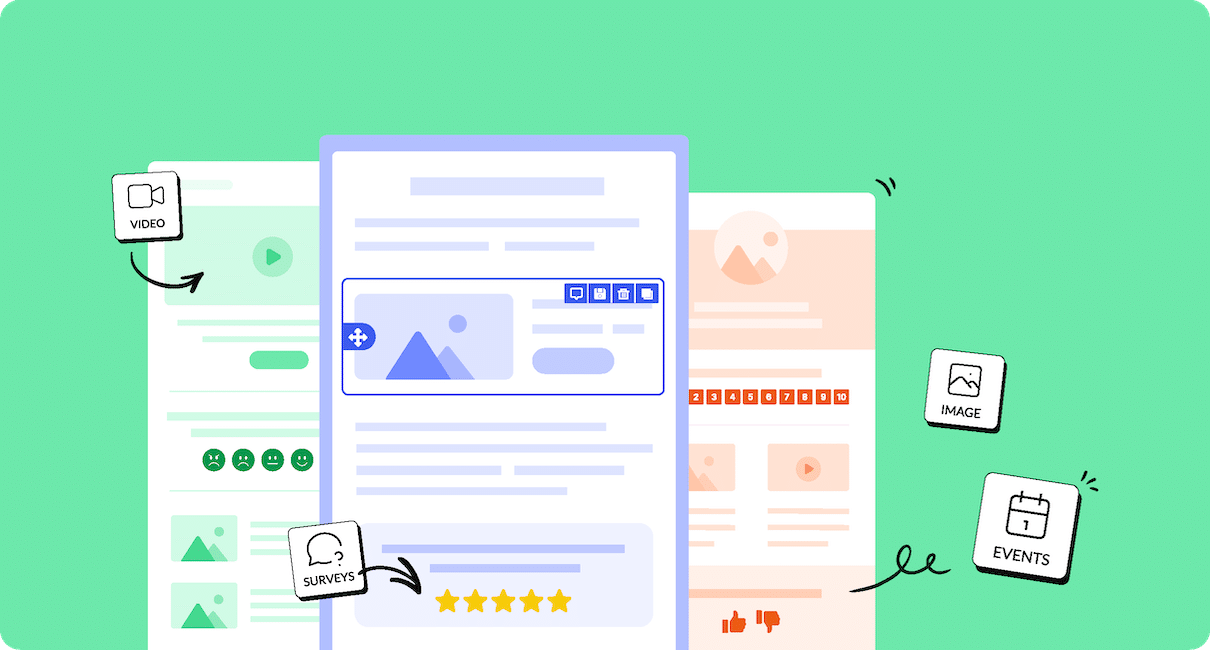Great newsletters engage employees, while the best ones facilitate two-way communication through surveys and teamwide interaction. Get inspired by these top 10 employee newsletter survey questions and start gathering meaningful information from your employees.
Employees of today’s workforce—particularly Millennials and Gen Z —have different expectations around workplace communication. They prefer open, transparent, and two-way communication channels where they can voice their opinions and receive feedback. This generational shift is driving organizations to adopt more inclusive and participatory communication practices where genuine employee engagement means more than just periodic updates.
Incorporating an employee newsletter survey into your emails can be a transformative strategy, enhancing communication and providing invaluable data. Survey functionality is one of the many benefits to using employee newsletter software – more data, more knowledge, grants you more success. The pace of change in the business world has accelerated too, requiring organizations to be more agile and responsive. Through surveys, internal communicators enable this agility that allows for honest feedback and early responses to identified challenges (or successes).
Let’s break down how to get useful information from employee feedback surveys and share the top 10 employee newsletter survey questions.
Learn about ContactMonkey’s employee newsletter solution – it’s so easy to create and add surveys to newsletters and emails. Then, track and analyze the results.
Take a self-guided tour of ContactMonkey
See how our key features can streamline your internal communications.
Take product tour

Why Your Company Should Use Surveys in Employee Newsletters
Integrating an employee newsletter survey into your staff newsletters is more than a creative addition. It’s a strategic move with multiple advantages for boosting team morale, productivity, and even collaborative innovation. Here’s why employee surveys are important:
1. Increase engagement rates
When you embed an employee newsletter survey into a traditional newsletter, your email instantly transforms into an interactive tool that encourages employees to engage more deeply. We know that engaged employees perform better, but, the question remains “What’s the best way to engage our workforce”? A survey for your employee newsletter invites team members to share their thoughts and offers insight into what exactly drives them. Using this data helps to tailor your engagement strategies to truly motivate and excite your team.
Typical metrics leveraged to measure engagement rates include:
- Job satisfaction: How satisfied employees feel at work.
- Alignment with company goals: Understanding and commitment to organizational objectives.
- Advocacy: Willingness to recommend the company as a great place to work.
- Retention: Employee turnover rates.
- Absence rates: Frequent unplanned absences can indicate low engagement.
Learn the easy steps to measuring staff newsletter performance.
2. Access immediate feedback
One of the main benefits of employee engagement surveys is the ability to obtain real-time feedback. Unlike annual surveys or focus groups, which may not provide timely insights, an employee newsletter survey offers a way to quickly assess employee sentiment and reactions. Deloitte’s research shows that organizations leveraging real-time employee newsletter feedback better address issues and adapt swiftly to changes, improving overall organizational responsiveness. An example of the kind of feedback you can receive in real-time:
- Question example: “How valuable did you find this month’s newsletter?”
- Answer options: Not valuable, somewhat valuable or very valuable.
- Feedback received: This type of question can help measure the impact of the newsletter’s content and gauge whether employees will continue digesting the information or if you need to make changes.
3. Enable data-driven decision making
An employee newsletter survey provides actionable data that drives decision-making. According to the Harvard Business Review, companies that use data-driven decision-making are 5% more productive and 6% more profitable than competitors. By integrating a survey into your newsletter, you can collect valuable data that helps assess the impact of new initiatives and align strategies with employee needs. Examples of data you can capture through surveys include:
Employee satisfaction:
- Data captured: Levels of overall job satisfaction, satisfaction with management, and specific aspects of the workplace environment.
- Utility: Helps identify areas where improvements can enhance employee morale and reduce turnover.
Professional development needs:
- Data captured: Employee interest in and perceptions of available training and development opportunities.
- Utility: Helps tailor development programs to employee needs, enhancing skills and career progression opportunities.
Cultural alignment:
- Data Captured: How well employees feel they fit into the company culture and their alignment with the company’s values and goals.
- Utility: Helps to reinforce or realign corporate culture to ensure that it supports employee retention and recruitment.
Create and send employee surveys for feedback
Engage staff with pulse surveys, eNPS surveys, reusable surveys, custom polls, and more. Ready to send modern emails?
Explore survey features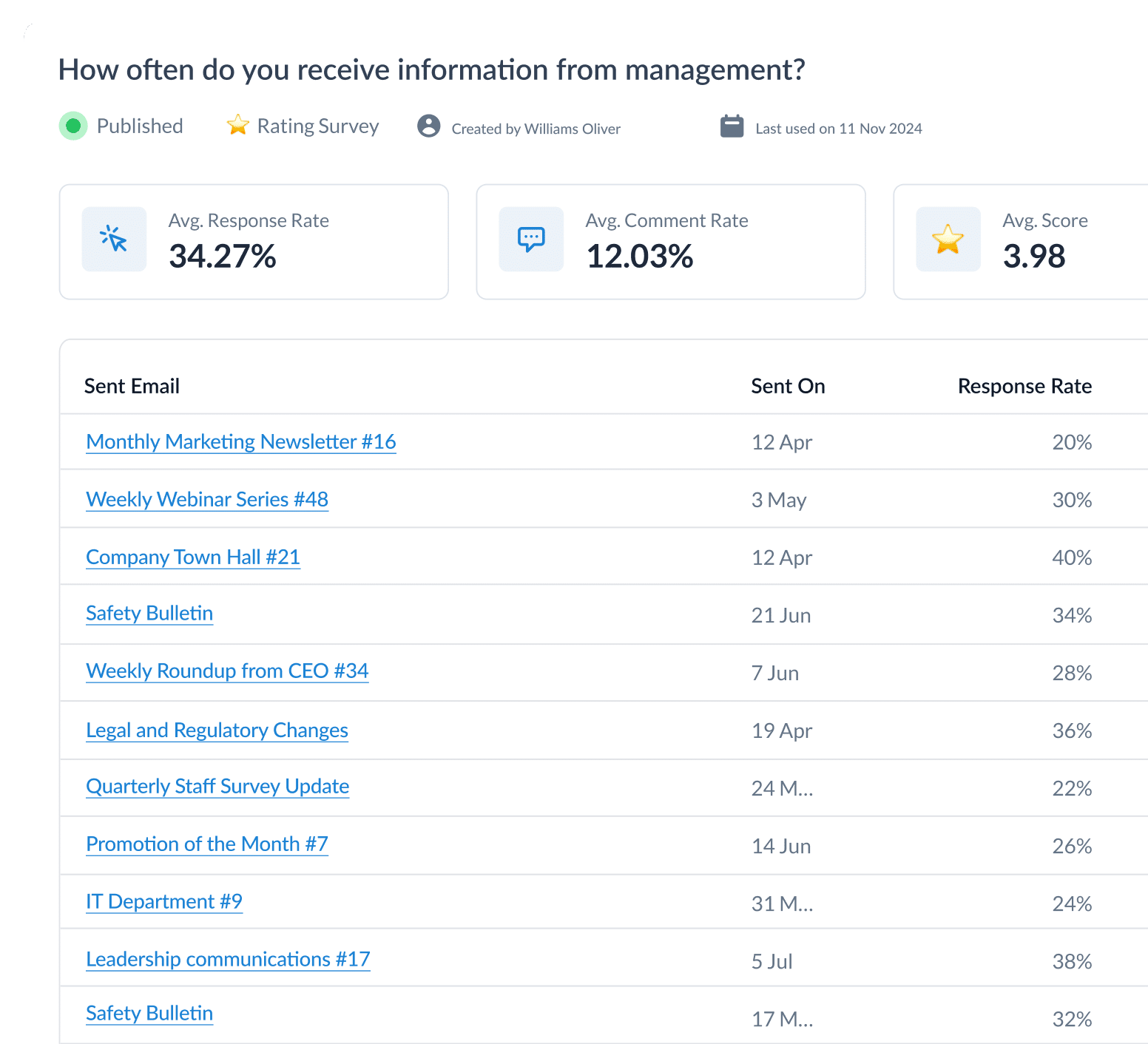
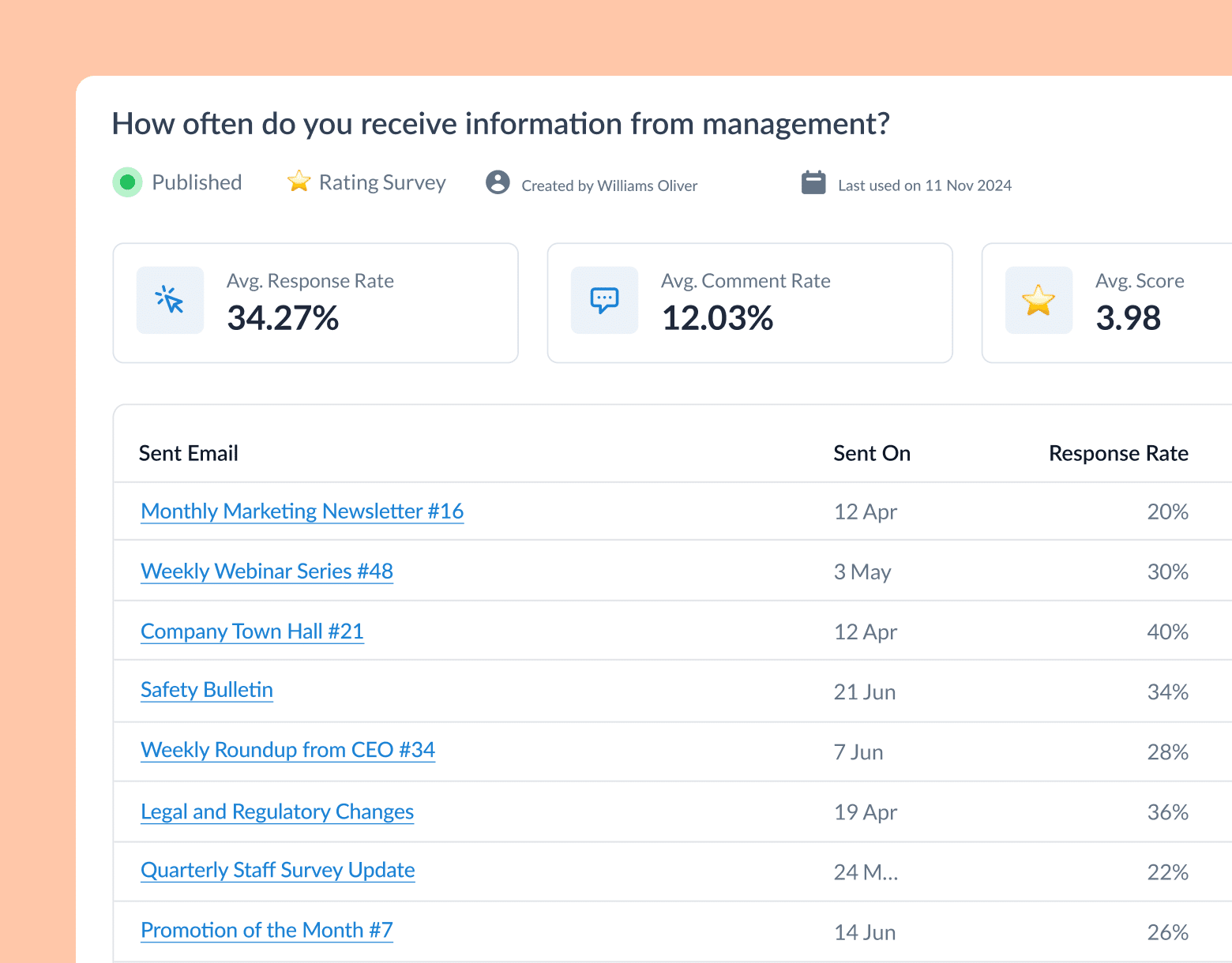
4. Strengthen communication channels
Incorporating an employee newsletter survey fosters a two-way communication channel between employees and management. Surveys in newsletters enhance the communication flow, promoting transparency and trust, while ensuring that employees feel their voices are heard.
In practice example: After you gather survey feedback, to demonstrate transparency, share the results through a summary and highlight key insights in the following newsletter. Couple this with a note on how management plans to address certain issues to show employees that their feedback is taken seriously and acted upon.
Go deeper on why employee newsletters are important and why you should strengthen your internal communications using ContactMonkey.
5. Tailor content and strategies
An employee newsletter survey helps tailor content and strategies to meet employees’ preferences. By asking employees what topics they want to see covered or how they prefer to receive information, you can make your newsletters more relevant and effective. This is key for creating internal communications that your employees will respond to, thereby serving as an effective distribution (and feedback) channel.
In practice example: If your survey data signals that employees don’t have the time to read highly detailed content, video content would be a better fit. Implement a monthly video update and include it at the top of your newsletters for staff members to quickly digest the information. Videos for internal communications work well for busy teams!
6. Track changes over time
Regular employee newsletter surveys are instrumental in tracking changes in employee attitudes and satisfaction over time. This longitudinal data is key for assessing the effectiveness of initiatives and tracking progress.
Specifically, surveys can measure any changes in the following aspects of your organization:
- Employee Net Promoter Score (eNPS): This metric indicates employees’ willingness to recommend their workplace to friends and family. Surveys track changes in Employee Net Promoter Score, providing insights into overall employee loyalty and satisfaction over time, especially before and after significant changes or initiatives.
- General response rates: Monitoring the response rates to surveys themselves is crucial. A high response rate can indicate a highly engaged workforce, while a low response rate may signal disengagement or dissatisfaction with the organizational communication channels. Tracking these rates over time can also indicate how employees feel about the organization’s openness to their feedback.
- Leadership changes: Employee reactions and perceptions regarding changes in leadership or leadership styles are effectively captured through surveys, offering feedback on the impact of new leaders.
7. Increase participation
Embedding surveys directly within newsletters typically leads to higher participation rates. This approach ensures that the feedback you gather is more comprehensive and representative of your workforce. Having interactive pulse surveys, clickable emojis, and polls also makes your content more exciting to the reader. It’s a win-win for learning about your workforce while providing more dynamic and entertaining content.
Want to make your staff newsletter even better? Check out our complete guide to employee newsletters.
How to Add Surveys to Your Internal Company Newsletter
Adding an employee newsletter survey with reportable results into your newsletters is easier than you think! Especially with tools like ContactMonkey. Here’s a step-by-step guide to help you create and conduct employee engagement surveys:
1. Choose the right embedded survey tool for internal emails
Not all internal communication tools are created equally. When it comes to adding surveys to your internal emails, you will likely need to adopt one of the best internal newsletter platforms. Here’s how to go about selecting the right survey platform for your organization’s email needs:
- Define your goals: First thing’s first—make sure you understand your company’s unique needs. Are you struggling with siloed information or lack of transparency? Do you need to improve collaboration across remote teams? Or is your primary objective to boost employee engagement and foster a sense of community? Clearly defining your needs will help narrow down your options and ensure that the tool you choose addresses your organization’s unique challenges.
- User-friendliness and adoption potential: Another consideration for your evaluation is how user-friendly the tool is and how much adoption potential there is. Look for intuitive interfaces, seamless integrations with existing systems, and mobile-friendly options to ensure accessibility from anywhere, at any time. Check out this post on the best employee feedback software and tools you can review.
- Security and data privacy: Don’t compromise on security features. Robust encryption, access controls, and compliance with industry standards should be non-negotiables. ContactMonkey’s security features guarantee GDPR compliance, offers single sign-on and ensures operations meet the highest industry standards through SOC 2 Type 2 certification.
- Scalability and future growth: While your current needs may be the driving force behind your tool selection, it’s crucial to think long-term. A tool that can adapt to your changing requirements will save you from the hassle and disruption of migrations, new IT approvals, onboarding etc.
- Ease of integration: Don’t overlook integration capabilities. Seamless integrations not only ensure a consistent user experience but also facilitate data sharing, reducing the risk of siloed information and enhancing overall efficiency. If the survey tool can perform more than one function, offers good reporting, and can sit atop your existing email provider (like Outlook or Gmail), then it’s game on! Check out these ContactMonkey integrations for more info.
ContactMonkey is a powerful tool designed to drive engagement no matter the industry or the organization. Plus, it checks off all of the points in this decision-making checklist! You’ll find user-friendly features that simplify the creation, integration with Outlook and Gmail, and full analysis of surveys. And, with ContactMonkey, you can collect any employee feedback, ensure that your surveys align with your communication objectives, and seamlessly embed them into your newsletters in minutes!
2. Create a one-time or reusable survey
Onward to designing your survey. Ensure that your employee newsletter survey questions are clear, concise, and aimed at achieving specific goals.
- Define objectives: Clearly outline what you want to achieve with the employee newsletter survey. Whether it’s gathering feedback on recent changes or understanding employee satisfaction, having a clear objective will guide your question design.
- Draft questions: Develop your survey with a mix of question types, such as multiple choice, Likert scale, and open-ended questions. For effective employee newsletter survey questions, ensure they are straightforward and designed to elicit actionable feedback.
- Test and revise: Test your survey with a small group before finalizing it. This ensures that the survey functions well and collects meaningful data.
3. Embed the survey into your email newsletter
Once your survey is designed, use ContactMonkey’s embedding feature to integrate it into your newsletter as an employee survey best practice. This seamless integration helps maintain user engagement by keeping the survey within the newsletter.
- Use embed codes: ContactMonkey provides embed codes for integrating surveys. This feature ensures that employees can participate without leaving their inboxes, making the process more convenient.
- Optimize for mobile: Since many employees access newsletters via mobile devices, a responsive employee newsletter design is crucial for maximizing participation. Make sure your survey is mobile-friendly by previewing the content for different devices.
4. Preview your survey and test
Before sending out the newsletter, preview and test the embedded survey to see whether everything is working correctly. This step helps identify any technical issues or formatting problems that could impact the user experience.
- Conduct a test run: Send a test version of the newsletter to yourself or a small group to verify the survey’s functionality and layout.
- Check functionality: Ensure that all survey questions are visible, clickable, and easy to navigate. This ensures a smooth experience for employees.
Watch ContactMonkey LIVE in action
Join live demo
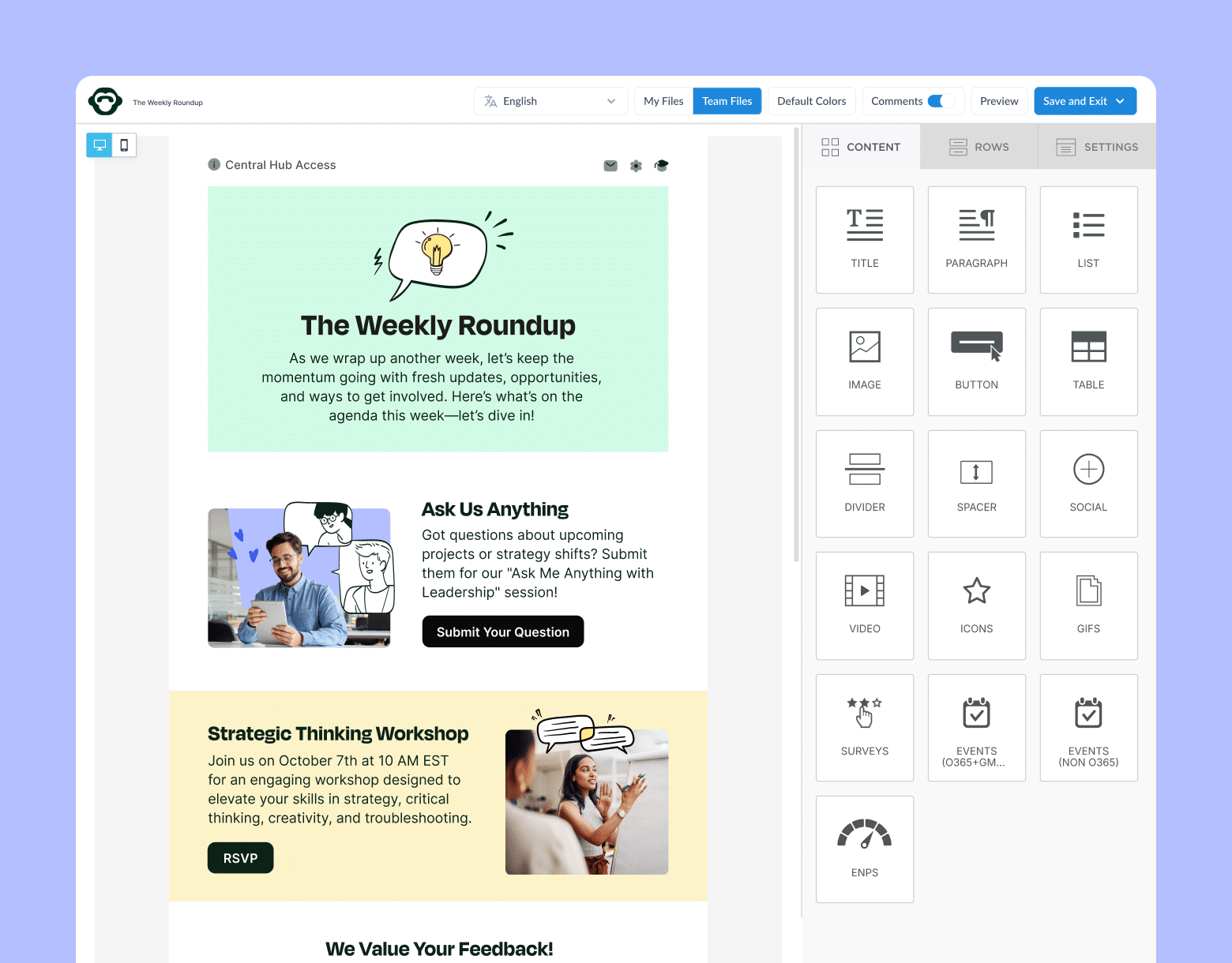
5. Send your email newsletter survey
Send out your newsletter with the embedded survey to your employee distribution list. Use ContactMonkey’s analytics tools to monitor participation rates and gather data.
- Track responses: Monitor response rates in real-time using ContactMonkey’s internal newsletter analytics features. This helps you gauge newsletter engagement and identify any issues with survey participation.
- Follow-up: If necessary, send follow-up reminders (through ContactMonkey, you can send follow-ups to only those who haven’t already participated) or use other communication channels to encourage participation.
6. Analyze results
After collecting responses, use ContactMonkey’s reporting features to analyze the data. The analytics dashboard helps you derive actionable insights from the employee newsletter survey.
- Review data: Examine the survey results to identify trends and patterns. Look for strengths and areas for improvement based on employee feedback.
- Generate reports: Create detailed reports summarizing the findings and present them to relevant stakeholders. Use visual aids like charts and graphs to make the data more accessible and actionable.
Learn more about what you can do with ContactMonkey when you create an internal newsletter.
🎁 BONUS: Our newsletter checklist will ensure that you don’t miss any steps to creating engaging and effective newsletters.
The Best Internal Newsletter Survey Questions to Ask in 2026
Crafting effective employee newsletter survey questions is critical for getting genuine, unbiased responses from your employees. Employee newsletter feedback is not only valuable for internal communicators and leadership teams but also for employees themselves as they’re shown that their voices matter.
We asked our team of internal comms experts about the kind of questions that generate the greatest engagement and insights. Here are the top 10 examples of employee newsletter survey questions to gather a wide-range of fruitful employee inputs—from our team to yours:
1. How do you feel about the company’s direction and leadership?
Why it matters: Employees are increasingly seeking transparency and alignment with their organization’s goals and leadership. In fact, survey data from Gallup showed that only 23% of employees strongly agreed that they trusted the leaders within their organizations. To boost engagement, you’ll want to build the trust needed to engage employees. Trust = engagement!
This question gauges employees’ trust and confidence in the company’s vision and leadership, which is crucial for fostering engagement and commitment.
Direct question:
- “How do you feel about the company’s direction and leadership?” Please rate on a scale from 1 (very dissatisfied) to 5 (very satisfied).
Follow-up for more insight:
- “What specific aspects of the company’s direction or leadership are you most satisfied with or most concerned about? Please elaborate.”
Comparative question:
- “Compared to last year, how has your perception of the company’s direction and leadership changed? Has it improved, remained the same, or declined? Please explain your answer.”
What to do with the information:
- Analyze feedback to identify strengths and areas needing improvement in leadership practices and company direction.
- Implement targeted leadership development and strategic communication enhancements.
- Share back findings and actions taken with employees to demonstrate responsiveness and foster transparency.
2. Do you feel supported in your career development and growth?
Why it matters: Career development remains a top priority for employees. A study by LinkedIn found that 94% of employees would stay at a company longer if it invested in their career development and this question can uncover gaps in training or development programs that need to be addressed to retain top talent.
Asking this employee newsletter survey question helps organizations understand whether employees feel they have opportunities for growth and advancement within the company.
Direct question:
- “Do you feel supported by our company in your career development and growth? Please rate on a scale from 1 (not at all supported) to 5 (fully supported).”
Follow-up for more insight:
- “On a scale of 1 to 5, how supported do you feel in your career development and growth at our company?”
- “Can you provide an example or elaborate on your experience related to career support?”
Comparative question:
- “Compared to previous years, how would you rate the support you receive for career development and growth now? Has it improved, stayed the same, or declined?”
3. How would you rate your work-life balance?
Why it matters: The balance between work and personal life has become a defining factor in employee satisfaction, especially with the ongoing shift towards flexible work arrangements. Poor work-life balance is a significant predictor of burnout, which the World Health Organization (WHO) now recognizes as an occupational phenomenon.
This question assesses whether employees feel they have a manageable workload and sufficient time for personal life.
Direct question:
- “How would you rate your work-life balance? Please rate on a scale from 1 (very poor) to 5 (excellent).”
Follow-up for more insight:
- “Can you provide specific reasons or factors that have influenced your rating of your work-life balance?”
Comparative question:
- “Has your work-life balance improved, declined, or stayed the same over the past year? Please explain any changes.”
What to do with the information:
- Use feedback to assess and potentially redesign policies affecting work-life balance, such as flexible working hours, remote work options, and workload management.
- Implement supportive measures and regularly communicate with employees about available resources and policy adjustments.
- Monitor the effectiveness of these changes and continue to seek employee input to refine approaches.
4. Do you feel your contributions are valued and recognized?
Why it matters: Recognition is a key driver of employee engagement. Employees who feel appreciated are more likely to be motivated, productive, and loyal to the company. Our Global State of Internal Communications reports that the best companies to work for excel in employee recognition. Many companies have recognized that employee recognition increases employee engagement this year, with 70% of respondents reporting that they have a formal employee recognition system in place at their organizations (an increase of 5% from 2023).
This question can help identify whether your recognition programs are effective or need enhancement.
Direct question:
- “Do you feel your contributions are valued and recognized by the company? Please rate on a scale from 1 (not at all) to 5 (extremely).”
Follow-up for more insight:
- “Please elaborate on why you feel your contributions are or are not valued and recognized. What factors contribute to your perception?”
Comparative question:
- “Compared to the previous year, do you feel that the recognition of your contributions has increased, decreased, or remained the same? Please explain any changes.”
What to do with the information:
- Analyze the feedback to pinpoint effective recognition practices and identify areas lacking recognition.
- Develop or enhance recognition programs that are visible, inclusive, and meaningful, such as peer recognition schemes, performance-based rewards, or regular feedback sessions.
- Communicate the outcomes of surveys and subsequent actions to the employees, reinforcing the organization’s commitment to valuing and recognizing each employee’s contributions.
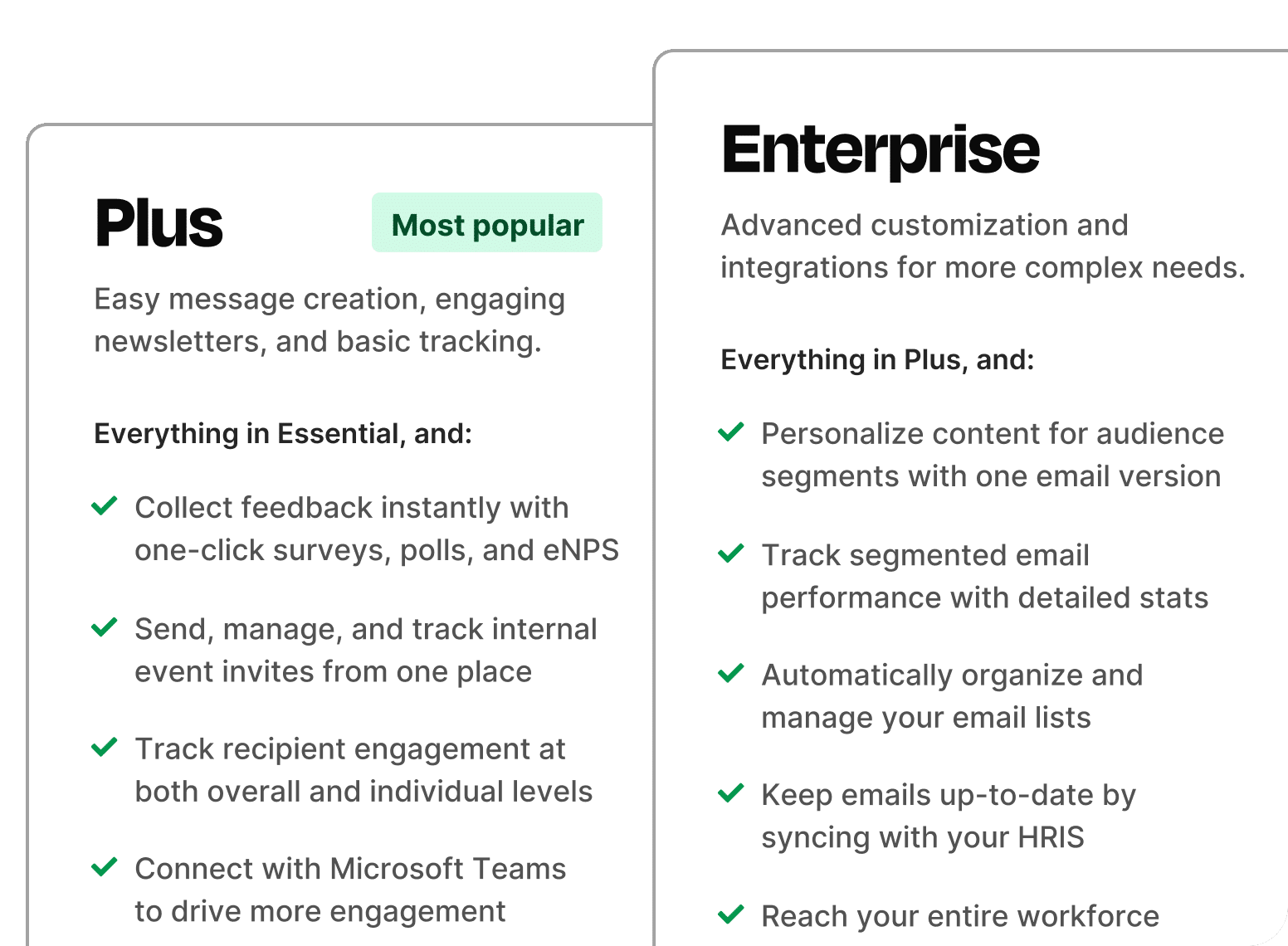
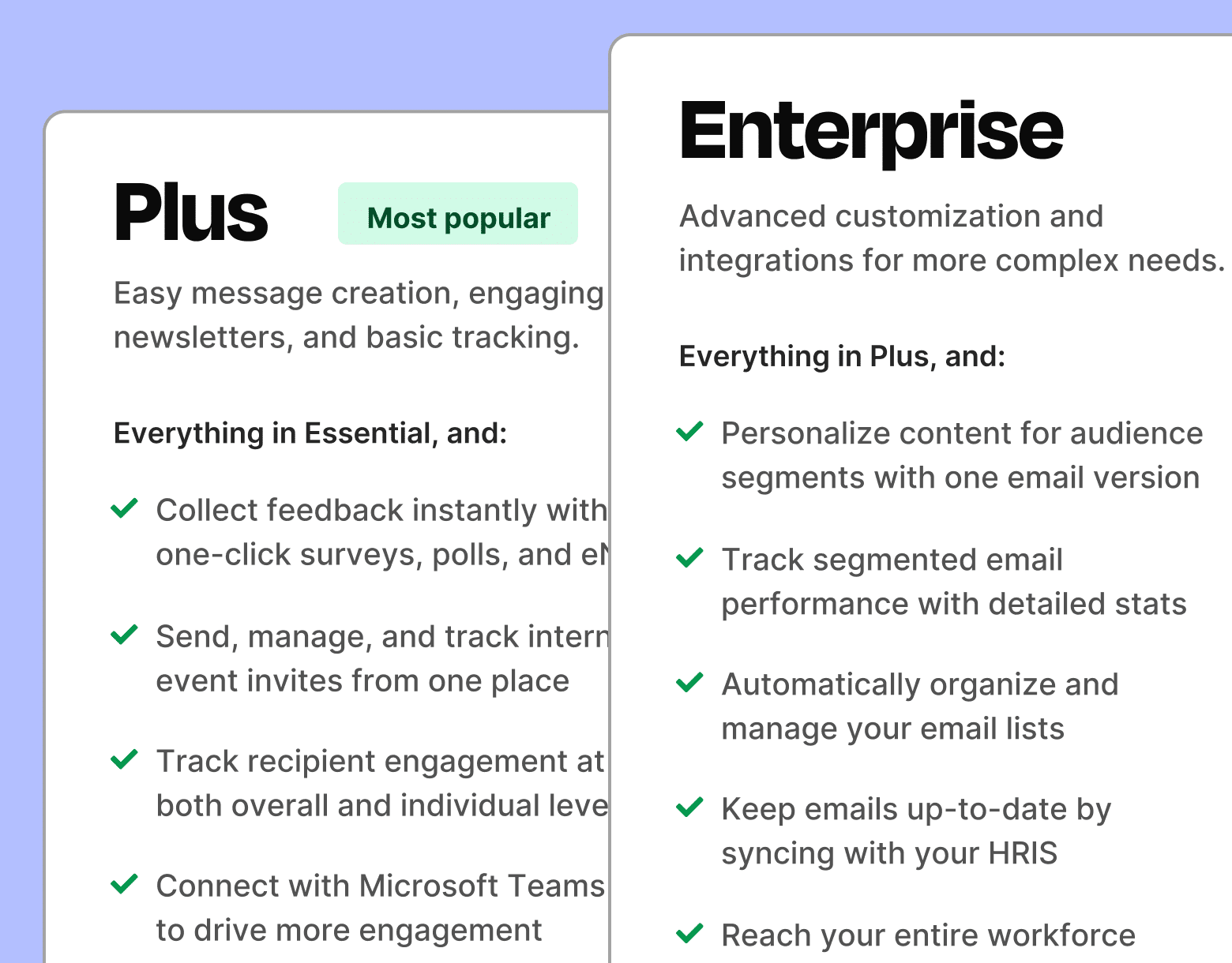
5. How effective is the communication within your team?
Why it matters: Effective communication is the backbone of successful teams, particularly in remote and hybrid work environments. According to a study by McKinsey, teams that communicate effectively are 25% more productive so this question will help you Identify communication gaps that lead to better collaboration and overall team performance.
This employee newsletter survey question helps assess the clarity and frequency of communication within teams and its impact on productivity.
Direct question:
- “On a scale from 1 (not effective) to 5 (very effective), how would you rate the communication within your team?”
Follow-up for more insight:
- “What specific aspects of team communication do you find effective or ineffective?”
Comparative question:
- “Has the effectiveness of communication within your team improved, worsened, or stayed the same over the past year?”
What to do with the information:
- Analyze patterns to identify common communication barriers.
- Develop targeted interventions, such as communication skills workshops or new collaborative tools.
- Share findings and planned improvements with the team, and monitor changes over time with follow-up surveys.
6. How satisfied are you with the tools and resources provided for your work?
Why it matters: Technology continues to play a critical role in how employees perform their jobs. In fact, some studies estimate that machine learning and AI will contribute to a labor productivity increase of 37% by 2025 which begs the question “what kind of tools exactly should teams be equipped with?”
This employee newsletter survey question helps determine if employees have the necessary tools and resources to work efficiently while offering insight into the kind of tools you should be investing in.
Direct question:
- “How satisfied are you with the tools and resources provided for your work? Rate from 1 (very dissatisfied) to 5 (very satisfied).”
Follow-up for more insight:
- “Please specify which tools or resources meet your needs and which do not.”
Comparative question:
- “Compared to last year, how has your satisfaction with workplace tools and resources changed?”
What to do with the information:
- Identify specific tools or resources that need improvement or upgrading.
- Consider investing in new technologies or training programs.
- Communicate the feedback to IT and facilities management for action.
7. Do you feel that the company supports diversity and inclusion?
Why it matters: Diversity, equity, and inclusion (DEI) initiatives remain at the forefront of organizational priorities nowadays. Gen Zs and Millennials in particular have reported that they would be willing to turn down jobs if they don’t align with their sense of purpose and personal ethics, in accordance with Deloitte. And, DEI is key for this group when evaluating companies and job offers or how long they stay at a particular organization.
Understanding employee perceptions of DEI can help organizations refine their policies and initiatives.
Direct question:
- “Do you feel that the company supports diversity and inclusion? Rate from 1 (not at all) to 5 (fully).”
Follow-up for more insight:
- “Can you provide examples or experiences that have shaped your view?”
Comparative question:
- “Has your perception of the company’s support for diversity and inclusion changed over the past year?”
What to do with the information:
- Review policies and programs for inclusivity.
- Organize diversity training and inclusive team-building activities.
- Regularly share diversity and inclusion goals and progress updates with employees.
8. How likely are you to recommend our company as a great place to work?
Why it matters: As we touched on above, the eNPS, provides a snapshot of overall employee satisfaction and loyalty. A high eNPS indicates that employees are likely to recommend the company to others, which correlates with higher retention rates and a positive workplace culture.
By asking this question, you’ll get a gauge on your current eNPS score and use the data to plan for engagement initiatives accordingly.
Direct question:
- “On a scale from 0 (not likely) to 10 (extremely likely), how likely are you to recommend our company as a great place to work?”
Follow-up for more insight:
- “What are the main reasons for your rating?”
Comparative question:
- “How has your likelihood to recommend our company changed over the past year?”
What to do with the information:
- Use feedback to enhance employer branding and recruitment strategies.
- Address specific areas that detract from the employee experience.
- Celebrate and build on strengths that make the company recommendable.
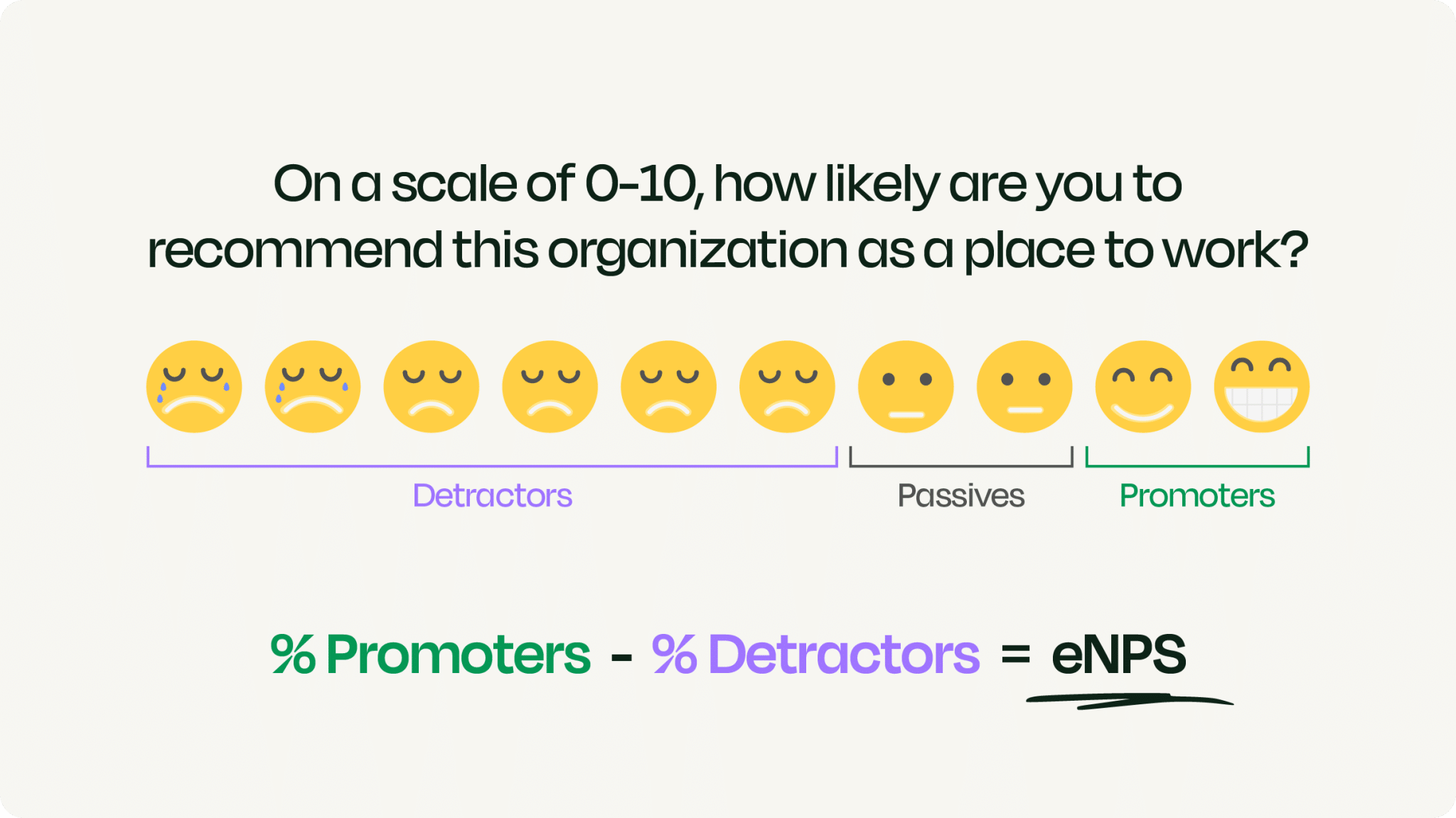
9. Do you have the flexibility you need in your role?
Why it matters: Flexibility is increasingly becoming a non-negotiable aspect of modern work, especially with the growing popularity of remote and hybrid work models. In fact, Research by PwC indicates that flexible work options are a top priority for 88% of employees.
This question helps assess whether employees feel they have the autonomy to manage their work in a way that suits their personal circumstances and how they feel about their work environment. By understanding employees’ needs for flexibility, this can help in designing more accommodating work policies.
Direct question:
- “Do you have the flexibility you need in your role to manage work-life balance effectively? Yes/No”
Follow-up for more insight:
- “What type of flexibility would you need to improve your effectiveness and satisfaction at work?”
Comparative question:
- “How has the level of flexibility in your role changed compared to last year?”
What to do with the information:
- Consider flexible working policies such as telecommuting or flexible hours.
- Communicate any changes or enhancements in flexibility policies.
10. What one change would make the biggest positive impact on your work experience?
Why it matters: Sometimes the most valuable insights come from open-ended questions. This question encourages employees to share specific suggestions for improvement, which can lead to meaningful changes.
This question not only gives employees a voice but also provides actionable insights that can drive positive change.
Direct question:
- “What one change would make the biggest positive impact on your work experience?”
Follow-up for more insight:
- “Why would this change be impactful for you?”
What to do with the information:
- Identify common themes and feasible changes that can be implemented.
- Prioritize changes based on impact and feasibility.
- Inform employees about how their feedback is being used to shape policy and practice improvements.
Design Engaging Newsletters and Get the Insights You Need From Surveys with ContactMonkey
Integrating surveys into employee newsletters offers a dynamic approach to internal communication, allowing you to enhance engagement, gather real-time feedback, and make data-driven decisions.
It takes the right kind of integrated internal comms tools that will make your life easier and, offer you actionable insights through employee newsletter surveys. With tools like ContactMonkey, you can easily design, embed, and analyze surveys, making the process efficient and effective.
The top 10 survey questions outlined here are designed to address key areas of employee experience, providing feedback that can drive meaningful improvements in your organization. Now that you know how to use surveys in employee newsletters, you can create a more responsive, engaged, and informed workforce!
Ready to explore employee engagement and feedback further? Book a free demo of ContactMonkey with advanced survey capabilities and learn how you can achieve the highest participation rates, today!





